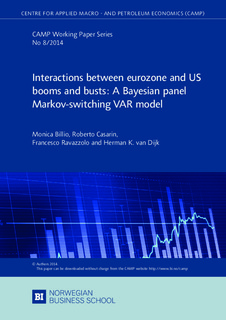Interactions between eurozone and US booms and busts: A bayesian panel Markov-switching VAR model
Working paper
Permanent lenke
http://hdl.handle.net/11250/227861Utgivelsesdato
2014Metadata
Vis full innførselSamlinger
Sammendrag
Interactions between eurozone and United States booms and busts and among major
eurozone economies are analyzed by introducing a panel Markov-switching VAR model.
The model is well suitable for a multi-country cyclical analysis and accommodates
changes in low and high data frequencies and endogenous time-varying transition
matrices of the country-specific Markov chains. The transition matrix of each Markov
chain depends on its own past history and on the history of other chains, thus allowing
for modelling the interactions between cycles. An endogenous common eurozone cycle
is derived by aggregating country-specific cycles. The model is estimated using a
simulation based Bayesian approach in which an efficient multi-move algorithm is
defined to draw time-varying Markov-switching chains. Using real and financial data
on industrial production growth and credit spread for all countries, our main empirical
results are as follows. Recession, slow recovery and expansion are empirically identified as three regimes with slow recovery becoming persistent in the eurozone in recent years differing from the US. US and eurozone cycles are not fully synchronized over the 1991-2013 period, with evidence of more recessions in the eurozone, in particular during the 90's. Larger synchronization across regions occurs at beginning of the financial crisisbut recently more heterogeneity takes place. Cluster analysis yields a group of core countries: Germany, France and Netherlands and a group of peripheral countries Spain and Italy. Reinforcement effects in the recession probabilities and in the probabilities of
exiting recessions occur for both eurozone and US with substantial differences in phase
transitions within the eurozone. Finally, credit spreads provide accurate predictive
content for business cycle
uctuations. A credit shock results in statistically significant
negative industrial production growth for several months in Germany, Spain and US.
Our empirical result may serve as important information for the specification of a
coordinated policy between the eurozone and the US and within the eurozone.
